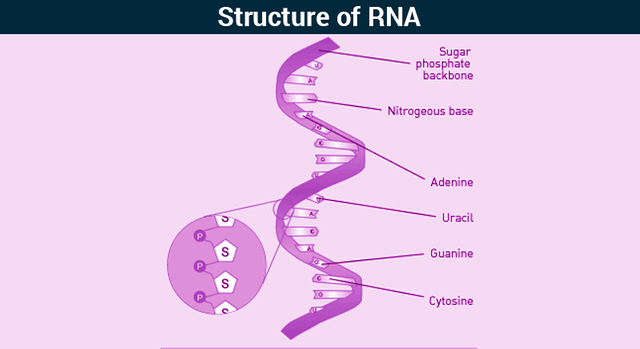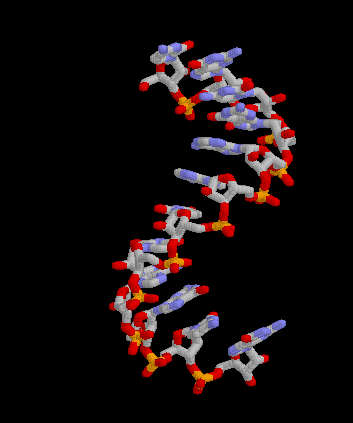CHEMISTRY OF NUCLEIC ACIDS: DNA REPLICATION AND DNA REPAIR #3
Welcome to another blog post, our last post was about the classes and features of DNA of their conformations.
Last post series click on:
NUCLEIC ACIDS: DNA REPLICATION AND DNA REPAIR #1
CHEMISTRY OF NUCLEIC ACIDS: DNA REPLICATION AND DNA REPAIR #2

Ribonucleic acid is a polymer of ribonucleotides of Adenine, Uracil, Guanine and Guanine and Cytosine, joined together by 3’ 0 5’ phosphodiester bonds. Thymine is absent in RNA. RNA is found in the nucleolus, Nissl granules. Ribosomes, mitochondria and cytoplasm. The pentose sugar of the nucleotide is D-ribose.
Structures of RNA:


Primary Structure of RNA
- The primary structure of RNA is defined as the number and sequence of ribonucleotides in the chain.
- Each linear strand is held together by the ribonucleotides bound to each other by 3’ – 5’ phosphodiester bonds joining 3’ – OH of one nucleotide with the 5’ – OH of the next.
Secondary Structure of RNA
- The secondary structure of RNA involves various coil formation of the polyribonucleotide chain.
- These coil structures are stabilized by hydrophobic interactions between the purine and pyrimidine bases.
- There are intra-chain hydrogen bonds between G-C and A-U. The hydrogen bonds are the same as in DNA for G-C while N3 as well as C4 oxo group of uracil (or dihydrouracil) which pairs with adenine.
Tertiary Structure of RNA:
- The tertiary structure of RNA involves the folding of the molecule into three dimensional structures.
- The cross-linking also occurs at various sites stabilized by hydrophobic and hydrogen bonds producing a compactly coiled globular structure.
Types of RNA
There are mainly three types of RNA found in human being. They are:

- Messenger RNA or m-RNA,
- Transfer or soluble RNA or t-RNA, and
- Ribosomal RNA or r-RNA.
The main function of each of these RNA is protein synthesis. In human cells there are small nuclear RNA or Sn-RNA which are not involved in protein biosynthesis directly. They may have some role in processing of RNA and cellular architecture. They are found in nucleoplasm, nucleolus, perichromatic granules, and cytoplasm and vary in size from 90 nucleotides to 300 nucleotides. A large precursor of m RNA called as heterogeneous nuclear RNA or hnRNA is also found in the nucleus.
- Messenger RNA (m-RNA): This is the most heterogeneous class of RNA with respect to its size and stability. The molecular weight varies from 3 × 104 to 2 × 106. They consist of 103 to 104 ribonucleotides. It carries mainly adenine, guanine, cytosine and uracil as the major bases and methylpurines and methylpyrimidines as minor bases. The m-RNA molecules are formed with the help of DNA template strand (3’- 5’) during the process called ‘’transcription’’.. The m-RNA carries a specific sequence of nucleotides in ‘’triplets’’ called ‘’codons’’, responsible for the synthesis of a specific protein molecule. The 3’-OH end of most m-RNA molecules carries a polymer of adenylate ribonucleotides consisting of 20 to 250 residues in length. This is called as ‘’Poly A tail’’, the function of which is not yet fully understood but it seems to maintain the intracellular stability of the specific m-RNA by preventing the attack of 3’ – exonucleases. On the other hand, the 5’ –OH end of the m- RNA carries a cap structure consisting of 7 methylguanosine triphosphate. The Cap is probably involved in recognition of protein biosynthetic machinery and it helps in stabilizing the m- RNA by preventing the attack of 5’ – exonucleases. The protein synthesis begins at 5’ end of the capped structure of m- RNA.
Hn-RNA: In mammalian cells, the m-RNA that comes to cytoplasm is the product of processing of a precursor called, heterogeneous nuclear or hn- RNA.

CHARACTERISTICS
It is synthesized in the nucleus. · Has a half life of 23 minutes. · Has 400 to 4000 nucleotides and it is 10 to 100 times bigger than m-RNA. · Is bound to macromolecular proteins called ‘’informofers’’ and exists as ‘’heterogeneous ribonuclear proteins’’ (hn RNP). · 75% of hn RNA is degraded in the nucleus. Only 25% of the hn RNA forms a precursor of m-RNA (Pre-mRNA).
Thank you all for reading, till next time.
References
- Thoughtco.com: 4 Types of RNA
- Study.com: Differences Between RNA and DNA & Types of RNA (mRNA, tRNA & rRNA)
- ncbi.nlm.nih.gov: The Three Roles of RNA in Protein Synthesis
- Britannica.com: Rna
- Nature.com: Chemical Structure of RNA
- Scf.usc.edu : RNA Structure
